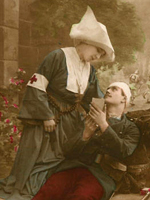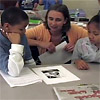Congratulations to Stacy Hoeflich, a 4th-grade teacher from John Adams Elementary School in Alexandria, VA, and a 20092010 Teachinghistory.org Teacher Representative, who is the 2011 National History Teacher of the Year!
The award, presented by the Gilder Lehrman Institute of American History, HISTORY® (History Channel), and Preserve America, honors K12 teachers for their use of primary documents in the classroom, the level of inspiration they provide their students, and their career achievements in education.
Ms. Hoeflich received the title and $10,000 award in a ceremony at the Frederick Douglass Academy in Harlem that included two of her former students, along with James Basker, president of the Gilder Lehrman Institute; Libby O'Connell, senior vice-president and chief historian, HISTORY®; Clement Price, vice chairman of the Advisory Council on Historic Preservation; and New York City Mayor Michael Bloomberg. Teachinghistory.org's Outreach Director Jennifer Rosenfeld attended the event representing Teachinghistory.org, which sponsored Ms. Hoeflich's nomination.
Dr. Kelly Schrum, Director of Teachinghistory.org, who nominated Ms. Hoeflich for the award, stated, "Hoeflich is devoted to the teaching and learning of history. After seeing the students in her classroom excitedly puzzle over a difficult map created almost 400 years ago or analyze political cartoons from the last century, students leave her classroom with a lifelong interest in understanding the complexities of the past."
An accomplished educator, Ms. Hoeflich has taught elementary school for 13 years. She has presented at local, state, and national education conferences on teaching history and historical thinking with primary sources. As a Teacher Representative for Teachinghistory.org, Ms. Hoeflich provided feedback about the website in order to improve its use by educators.
On Teachinghistory.org you can watch videos of Stacy Hoeflich teaching with maps and teaching with political cartoons.
Teachinghistory.org also has materials from previous National History Teacher of the Year winners. Check out 2008 winner David Mitchell's piece for our roundtable on organizing a U.S. History Survey Course or use 2005 winner Roseanne Lichatin's teaching guide on students working in historic preservation.
Teachinghistory.org is full of resources developed by other award-winning teachers, so be sure to check out our blog, teaching guides, and best practices videos to learn what outstanding teachers from across the country are doing in their classrooms!

